Retroflect has a long history at Broken Frontier, having been both a series of blogs and an ongoing column here in the past. Today we return to this irregular feature for looking at pre-millennium comics, from celebrated classics to obscure and largely forgotten titles. Our subject this time is a Marvel horror character whose adventures never attained the cult favourite status of Tomb of Dracula, Man-Thing or Werewolf By Night but nonetheless are not without their appeal. We talk, of course, of 1970s supernatural star N’Kantu, the Living Mummy. As ever decades-old spoilers are contained below…
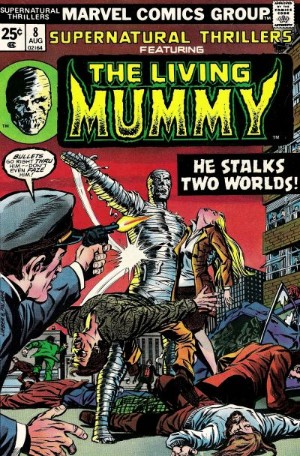 When Supernatural Thrillers debuted in 1973 – as part of the horror boom that saw so many new supernaturally themed series launched by Marvel at the time – it was one of the least focused of the Marvel monster books. What distinguished it though from so many of its contemporaries that didn’t feature one ongoing serial was that the material within its pages was all-new content. Unlike Chamber of Chills, Tomb of Darkness, Dead of Night and many others that reprinted and repackaged dated 1950s anthology shorts with all-new covers that promised far more than their interiors delivered.
When Supernatural Thrillers debuted in 1973 – as part of the horror boom that saw so many new supernaturally themed series launched by Marvel at the time – it was one of the least focused of the Marvel monster books. What distinguished it though from so many of its contemporaries that didn’t feature one ongoing serial was that the material within its pages was all-new content. Unlike Chamber of Chills, Tomb of Darkness, Dead of Night and many others that reprinted and repackaged dated 1950s anthology shorts with all-new covers that promised far more than their interiors delivered.
For its first six months readers were treated to adaptations of renowned novels and short stories including Theodore Sturgeon’s ‘It’, H.G. Wells’s ‘The Invisible Man’, Robert E. Howard’s ‘The Valley of the Worm’, and Robert Louis Stevenson’s ‘Dr. Jekyll and Mr. Hyde’. Often awkwardly crammed into a short single issue page count these truncated tales were perhaps more notable for the eye-catching covers they sported (below). But with its fifth and six issues Supernatural Thrillers took a different tack.
Issue #6 introduced readers to a new take on the Headless Horseman legend with a character who may or may not have been part of the Marvel Universe. Prior to that in #5 however Marvel gave us their version of the last of the 1930s/40s Universal horror icons to be re-imagined for the MU with the debut of N’Kantu, the Living Mummy. After a seven-month break between issues, Supernatural Thrillers returned in 1974 with #7 and the rotating feature status of the comic was dropped. From here until its (second) cancellation with #15, just over a year later, the book would be the permanent home of the Living Mummy, a series that has been much maligned over the years but on re-reading has far more to offer the reader than its notoriety would suggest.
Covers by Jim Steranko (left) and Ron Wilson, Ernie Chan & John Buscema (right)
Central character N’Kantu’s origin shares a number of similarities with that of Kharis from that four-movie 1940s Universal movies run. But unlike his predecessor N’Kantu is portrayed after his first couple of appearances as protagonist and hero rather than an unrelenting force of destruction. The first Living Mummy story, though, in Supernatural Thrillers #5 reads more like a throwaway, one-issue frightfest rather than a pilot for an ongoing series. It’s written by Steve Gerber but it’s noticeably subdued and formulaic for a writer whose 1970s work was usually anything but.
Set in two different timeframes we are introduced through the modern era narration of academic Dr. Alexei Skarab to the story of the ancient Swarili tribe in North Africa and their leader the warrior N’Kantu. Enslaved by the Egyptians the Swarili were forced to labour on monuments in tribute to the Pharaoh Aram-Set, who was assisted in his villainy by the high priest Nephrus (who in turn would prove to be the closest thing N’Kantu would have to an archenemy). The Swarili would eventually rebel against their captors with N’Kantu slaying Aram-Set in a dramatic confrontation. But Nephrus would wreak an awful revenge, firstly incapacitating him and then using an experimental process to put him in a state of suspended animation and burying him alive as a mummy. While Nephrus is killed shortly after, his victim is left to spend millennia in a state of living death until he is revived in the modern era.
Cover by Rich Buckler, Frank Giacoia and John Buscema
Driven mad by his ordeal N’Kantu escapes his tomb and journeys through the desert to Cairo where his rampage coincides with a field trip the anthropologist Skarab and his students Ron McAllister and Janice Carr have taken in the area. Nephrus, coincidentally, turns out to be Skarab’s ancestor and the Mummy in his confused state mistakes him for his enemy. As events draw to a close the now out of control, time-displaced warrior is apparently electrocuted and killed for good as the authorities close in on him.
When, after a long hiatus, Supernatural Thrillers returned the following year Val Mayerik had replaced Rich Buckler on visuals bringing an impressively creepy vibe to the proceedings that was missing from the TV movie feel of the original. Supernatural Thrillers #7 spends an inordinate amount of time recapping events from #5 which is hardly surprising given nearly a year had passed between chapters but when events pick up again the Mummy’s body has been transported to the States to be exhibited there.
Marvel’s horror comics of the era often trod very similar ground and there’s certainly a number of thematic similarities between the Living Mummy and both the Golem series in Strange Tales and Marvel’s The Monster of Frankenstein/The Frankenstein Monster. For the rest of this 9-issue second run of Supernatural Thrillers N’Kantu becomes embroiled in the plight of the otherworldly Elementals. Reawakening in a museum in New York the Mummy goes on a second rampage before regaining his memories and being mystically transported to the Elementals’ realm, with supporting cast Skarab, Ron and Janice’s stories still interweaved with his own.
Tony Isabella takes over the writing duties with #8 as N’Kantu finds himself traversing a Ditko-like weird dimension before meeting the Elementals, a group of exiled otherdimensional beings (made up of Hydron, Magnum, Zephyr and Hellfire). This foursome had once attempted to gain a foothold on the Earth as their new home but were stopped three and a half millennia ago by a warrior and a wizard who had used a sorcerous ruby scarab to ensure they were banished forever from the Earth. Using the Mummy as their puppet they seek to use him to destroy the scarab and allow them to return and conquer the planet.
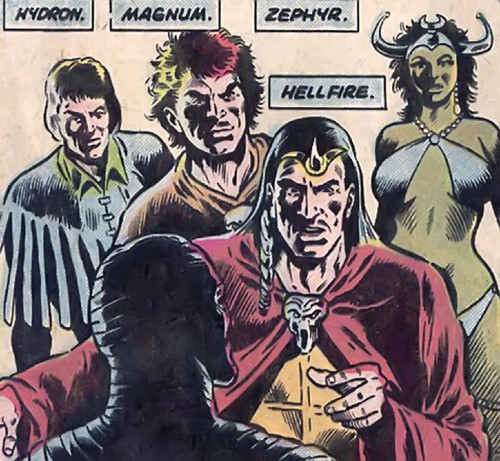
While clearly taking place in the Marvel Universe (there’s a reference to the Avengers in one issue) interactions with the super-hero community are strictly limited in Supernatural Thrillers. The one major exception is the Living Mummy’s meeting with the Living Pharaoh, the minor villain who first appeared in the pages of X-Men and, it is revealed, now has possession of the ruby scarab the Elementals are searching for. It’s a perhaps logical if unimaginative turn of events with matters being complicated further when the scarab is stolen by a mysterious thief while the Living Mummy and the Living Pharaoh pit themselves against each other.
There’s an awkward attempt at social commentary in Supernatural Thrillers #10 with the Mummy briefly drawn into local conflicts before the Elementals storyline moves onto its next chapter. The new owners of the scarab are revealed as professional thief the Asp and his partner-in-crime Miles Olddan (whose relationship may be closer than a business one depending on your interpretation). Although their initial motivations are purely selfish ones they too will be drawn into the saga of the Elementals, as all the supporting players to date find their paths crisscrossing. Eventually affiliated with Skarab, Janice and Ron, who have been tracking N’Kantu since the beginning, and Zephyr who has defected from her Elemental siblings, all parties and the Mummy find themselves established as a last line of defence against the Elementals’ conquest of the Earth.
Covers by Gil Kane and Al Milgrom (left) and Gil Kane and Klaus Janson (right)
With the Elementals finally having made their way to Earth they erect a force field around Cairo and declare themselves its rulers, as the struggle between them and the Mummy’s group for control of the ruby scarab begins. Local tensions rise between residents of the city determined to oppose their self-proclaimed rulers and those terrified of their new overlords. It all comes to a climactic finale when, after much chaotic conflict, Skarab uses the ruby scarab’s power against the Elementals by shifting Cairo into a crossroads dimension and focusing the allies’ collective mental energies to finally exile them once and for all.
While the last four instalments or so feel like something of a run-around at points, as the protracted schemes of the Elementals run on for more issues than there is plot to fill them (John Warner comes in mid-storyline as writer for the final two issues), there’s still a lot to admire here in terms of the unpredictability and playfulness of the strip’s storytelling structure. Mayerik is given plenty of truly dramatic double-page spreads to indulge himself in and at pivotal points in the narrative they add a powerful dramatic emphasis. Isabella also experiments with a number of illustrated prose sections that give detailed background information which would otherwise have been impossible for what is by now a sprawling supporting cast of players. He’s also unafraid to put an emphasis on other characters as narrative driving force over N’Kantu on occasion, giving the series an ensemble cast feel.
Covers by Gil Kane and Mike Esposito (left) and Gil Kane and Tom Palmer (right)
While some of the supporting cast and villains would go on to appear in Ms Marvel, N’Kantu would not be seen again until a brief cameo in Contest of Champions and in a co-starring role in the Thing’s team-up book Marvel Two-In-One #95 several years later. That latter story that would wrap up the arc of its long cancelled predecessor, (as MTIO was often used to do). Here, courtesy of writer David Anthony Kraft and artist Ron Wilson, the villainous Nephrus is reincarnated in another of his descendants’ bodies (the godhood-seeking Gamal Hassan) and the Thing’s girlfriend Alicia Masters is caught up in his schemes as a potential bride. While Nephrus is once again defeated and killed this story marks the final appearance of the Living Mummy for another several years, and his last headlining appearance to date.
There are undoubtedly cultural representations in Supernatural Thrillers that reflect that these stories were published the best part of half a century ago and that can’t be ignored. It’s also worth noting, though, that N’Kantu was also one of the very first Black lead characters in a Marvel series. His debut comes in the year after Luke Cage’s introduction and, arguably, his series precedes the Black Panther’s. If we don’t count the Panther’s headlining status in Jungle Action #5 (which was a reprint) then the Living Mummy becomes Marvel’s second Black hero to get their own series.
Covers by Gil Kane and Tom Palmer (left) and Ron Wilson and Chic Stone (right)
After the Marvel Two-in-One coda to Supernatural Thrillers, appearances of the Living Mummy were few and far between before the century was out. Mark Gruenwald used him twice, firstly in a brief sequence encountering Captain America in the multi-chapter ‘The Bloodstone Hunt’ in Captain America and then as a member of Dr. Druid’s Shock Troop of supernatural operatives in Quasar. He has popped up as a member of the Howling Commandos and the Legion of Monsters but each subsequent appearance over the years has taken N’Kantu further and further from what made him distinctive, turning him into just another Marvel monster character. Only a Jonathan Hickman-scripted short in the Legion of Monsters: Satana one-shot (2007) ever really unlocked his full potential with a clever new direction for the character as an agent of mystical retribution that was sadly never subsequently followed up on.
While it’s perhaps not the most memorable of Marvel’s ‘70s horror series, the Living Mummy’s run has far more to recommend it than its reputation would suggest. It’s no Man-Thing, Tomb of Dracula or even Tales of the Zombie, but despite multiple writers it does retain an identity of its own and visually embraces some of the experimental storytelling that make the more offbeat books in the 1970s Marvel line-up such a draw, even all these decades later. Those wanting to revisit these stories for themselves can find them most recently collected in the pages of the first Marvel Horror Omnibus, published in 2019.
Article by Andy Oliver





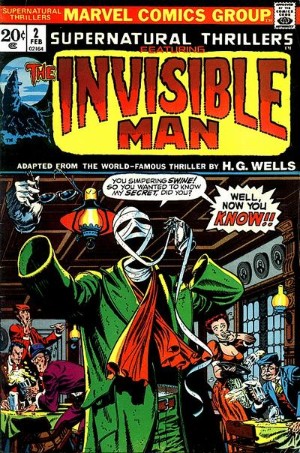
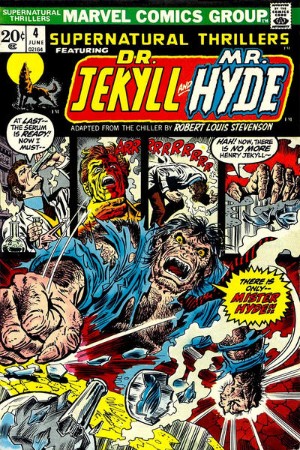
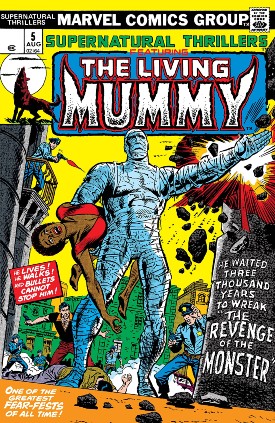
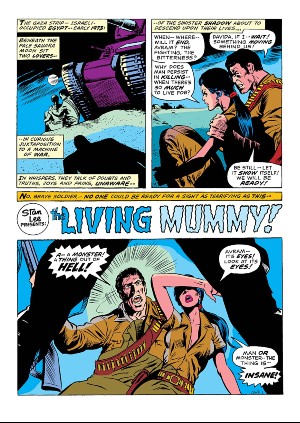
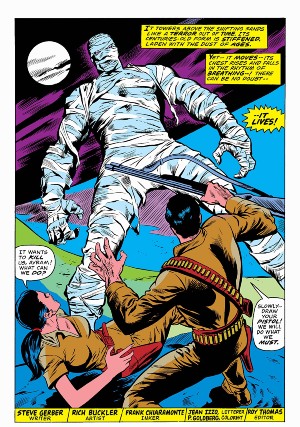
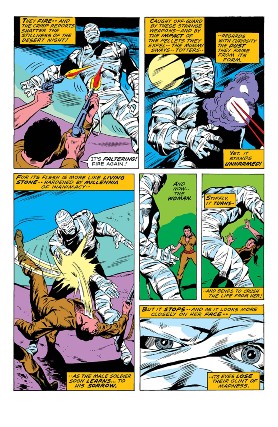
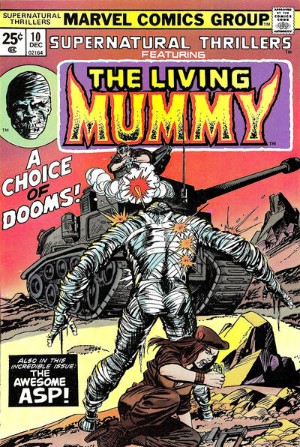
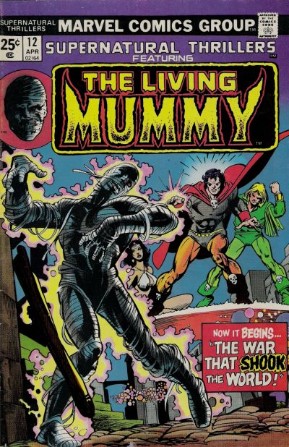
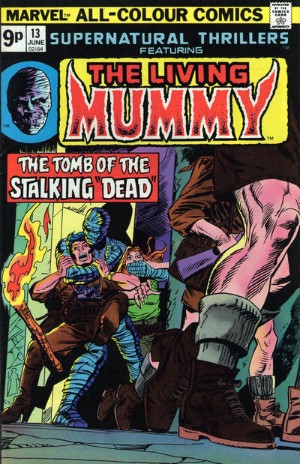
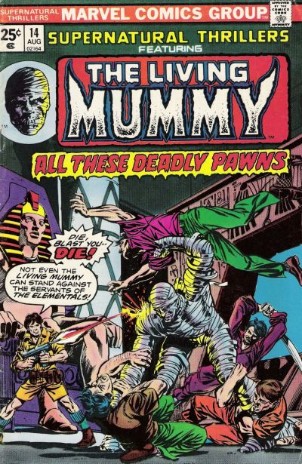
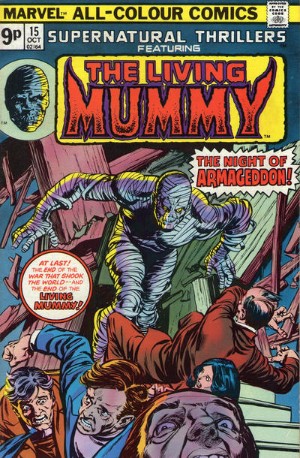
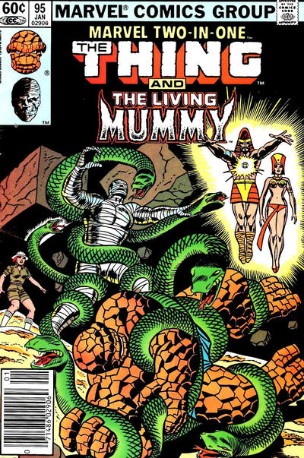
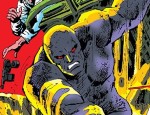
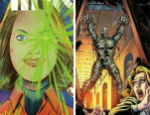
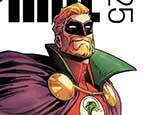
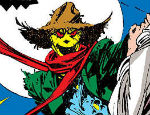





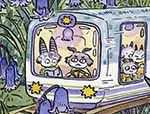
[…] horror comics to read as the nights draw in, while Broken Frontier’s Andy Oliver looks back to Marvel Comics’ horror boom of the 70s, including the underrated The Living […]